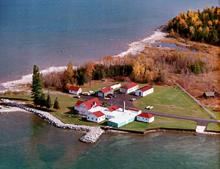Construction and renovation will begin next year on a $9.7 million aquatics laboratory facility at the Hammond Bay Biological Station in northern Michigan to support invasive species control and promote native species restoration.
The U.S. Geological Survey awarded the contract to construct a new laboratory facility, demolish vacated structures, construct new water intake and discharge lines from Lake Huron and overhaul the water system for all facilities at the station near Millersburg, northwest of Alpena.
“This major renovation will ensure our ability to attract world-class scientists to the region and lead innovative research for the 21st century,” says David Ullrich, Great Lakes Fishery Commission vice-chair.
The USGS Hammond Bay Biological Station was established in 1950 to develop measures to control sea lampreys, a parasitic fish, which parasitize other fish by sucking their blood. Researchers at this station developed ways to control sea lampreys, such as using of pheromones (odors) to attract lampreys to traps or repel them from streams.
With this new construction, the USGS Great Lakes Science Center will have three fish labs in the Great Lakes basin working together to support invasive species control. The other labs are located in Ann Arbor and Cortland, New York.






